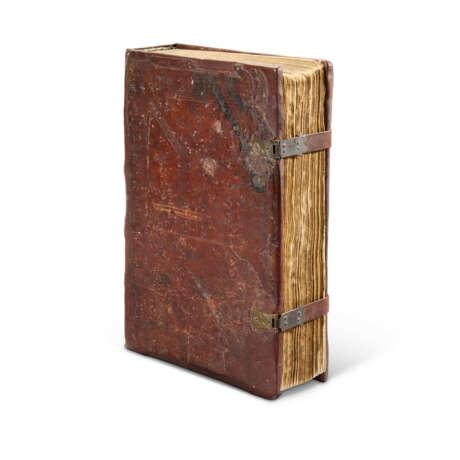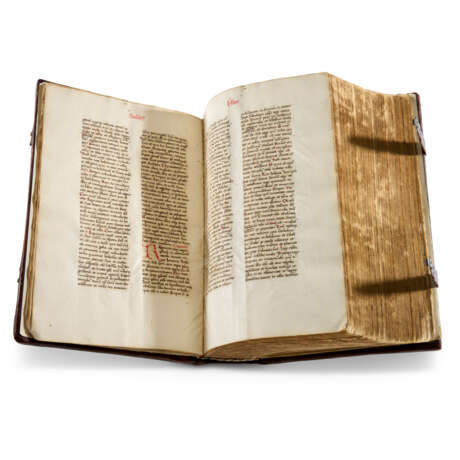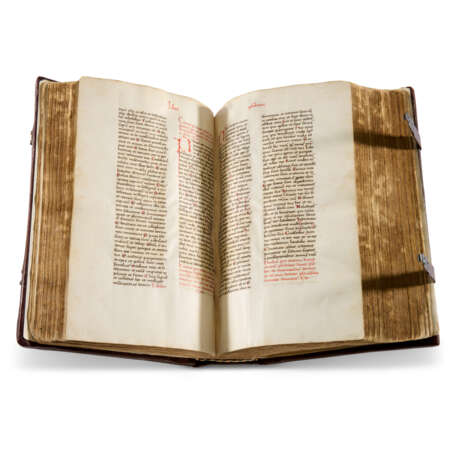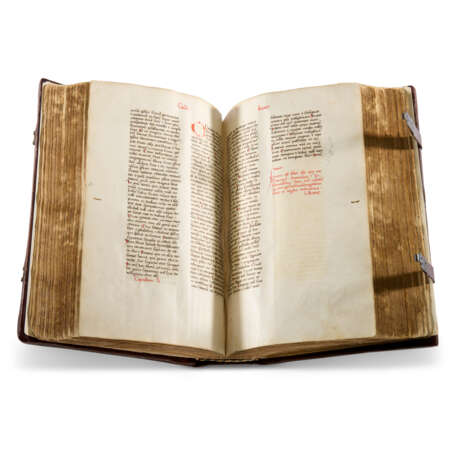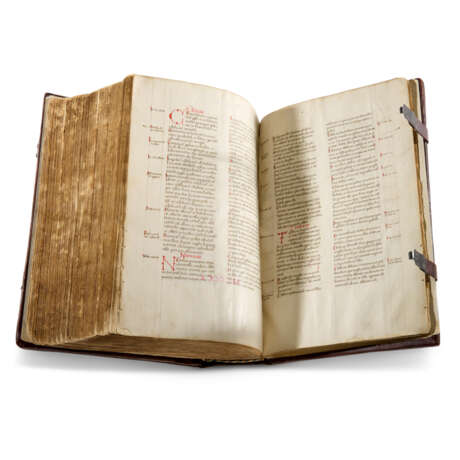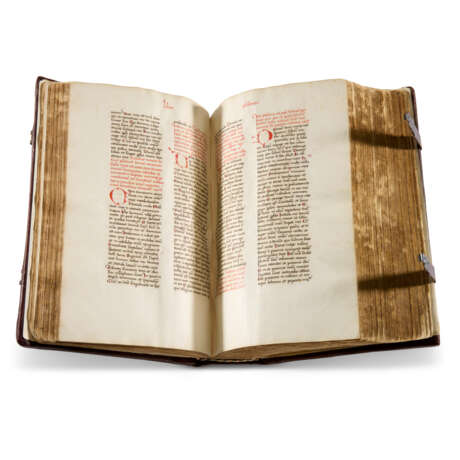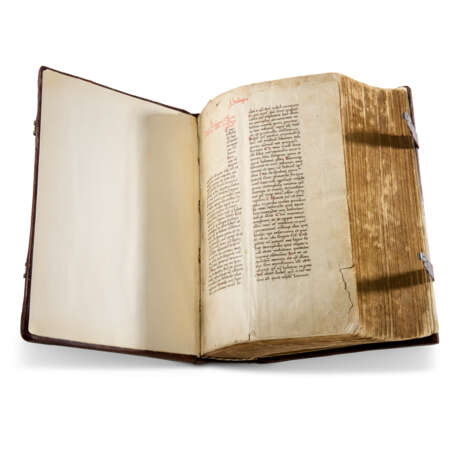ID 1214870
Los 48 | A calligraphic Bible in a dated binding
Schätzwert
£ 20 000 – 30 000
1 Ezra – 2 Maccabees from a Bible, with prologues and other accessory texts, in Latin, decorated manuscript on paper
Gundelfingen (Freiburg), 1466
A calligraphically-written Bible with unusual accessory texts, signed and dated by the scribe, in a dated and localised binding incorporating fragments of a 9th-century manuscript.
c.310 × 210mm, 400 leaves, ff.175v–179v are blank, lacking the first and last leaves of the first gathering (the first blank, the last with Nehemiah 6:10–71), else complete, collation: 110 (of 12, i cancelled, xii missing), 2–1512 (to f.178), 16–3212, 3310, 348, catchwords throughout except at the ends of the two codicological units, i.e. the last gathering and the 15th, which ends with the colophon and 7 blank pages, blind-ruled for two columns of 41 lines: c.210 × 140mm, written in a fine gothic hand as far as the final column of 2 Maccabees where it switches to a very fine humanistic minuscule, decorative chapter initials throughout in ornamental designs in in red, spaces left blank for very large initials, each biblical book starting at the top of a column, usually resulting in a partially blank preceding column (the upper margin of the first leaf excised, doubtless to remove an ownership inscription, some margins frayed or repaired, some slight worming, but the condition otherwise generally very good).
Binding:
Contemporary signed and dated binding sewn on four bands laced into wood boards covered with blind-stamped dark brown calf, stamped with an inscription around the outer edge of the upper cover, quatrefoil tools on the lower cover, with small stamps including ‘ihs’, ‘maria’ on a scroll, and a splayed eagle (very worn and partially defective, restored and re-backed in 1990, the clasps renewed and defective, modern paper endleaves).
This is a rare and unusual example of a dated and localised binding: around the frame of the front cover in gothic letters is ‘dns albertus / feistmantel(?) / in gundelfing / ano. d. M. CCCC. lxviii’. The binding incorporates vellum sewing-guards in the centre of each gathering, of which nine are from a finely-written early 9th-century manuscript written in black and red, apparently concerning St Peter; others are from a 15th-century legal document in German, mentioning Hadmar von Apolberg(?), Erckinger von Rochenberg zu Rochenberg(?), and others.
Provenance:
(1) Written by the scribe Heinrich Brewtlein, in Gundelfingen (adjacent to Freiburg, in the extreme south-west corner of Germany), on 1 July 1466, as recorded in his colophon at the end of of Ecclesiasticus: ‘Finitus est liber iste per me Heinricum Brewtlein In Gundelfing Anno domini milesimo quadringentesimo sexagesimo sexto in vigila visitationis Marie’ (f.175). The whole Bible was apparently not completed until 1468, when it was bound (see Binding); perhaps the first owner delayed binding the volume in the hope of getting it illuminated.
(2) ? Albrecht Feistmantl, 1468: the name on the front cover (see Binding) is likely to be that of the owner rather than the binder, as he is called ‘dominus’.
(3) Sotheby’s, 7 December 1982, lot 48, to:
(4) Alan G. Thomas, with his price-code on f.1v: Catalogue 46 (1984), no 2; bought by:
(5) The Schøyen Collection, MS 8.
Content:
The volume was presumably the second of three: the first would have contained the Old Testament from Genesis to 2 Chronicles and the third would have had the whole New Testament. The text extends from the usual prologue to 1 Ezra to 2 Maccabees: ‘Incipit prologus Beati Hieronimi presbyteri in Esdras propheta. Utrum difficilius […] Hic ergo erit consummatus’. The text has numerous differences from the standard ‘Paris’ Vulgate. Some books have capitula lists, for example, and several have unusual prologues. The book of Psalms, for example, which usually has no prologue, here has several: Stegmüller, Repertorium biblicum, no 443; ‘David filius Yesse cum esset in regno suo […]’ (PL, 142, col. 46); Stegmüller nos. 430, 426, 369, 384, and 398; each psalm also has a titulus, sometimes very long, and sometimes mentioning Nicholas of Lyra. Following the psalms are the incipits of eleven canticles, the Lord’s Prayer, the Apostles’ Creed, and the Athanasian Creed.
The main text is followed by a summary of the books from 1 Ezra to Malachi (the last of the prophets); the first paragraph for ‘Esdras’, for example, has a side-note ‘In anno primo’, and reads: ‘Cyrus solvit captivitatem populi & redditus vasis precipit populum ite in Hierusalem & edificare templum’.
| Herkunftsort: | Westeuropa, Deutschland, Europa |
|---|---|
| Kategorie des Auktionshauses: | Handschriften des Mittelalters und der Renaissance, Bücher und Handschriften |
| Herkunftsort: | Westeuropa, Deutschland, Europa |
|---|---|
| Kategorie des Auktionshauses: | Handschriften des Mittelalters und der Renaissance, Bücher und Handschriften |
| Adresse der Versteigerung |
CHRISTIE'S 8 King Street, St. James's SW1Y 6QT London Vereinigtes Königreich | |
|---|---|---|
| Vorschau |
| |
| Telefon | +44 (0)20 7839 9060 | |
| Aufgeld | see on Website | |
| Nutzungsbedingungen | Nutzungsbedingungen |
